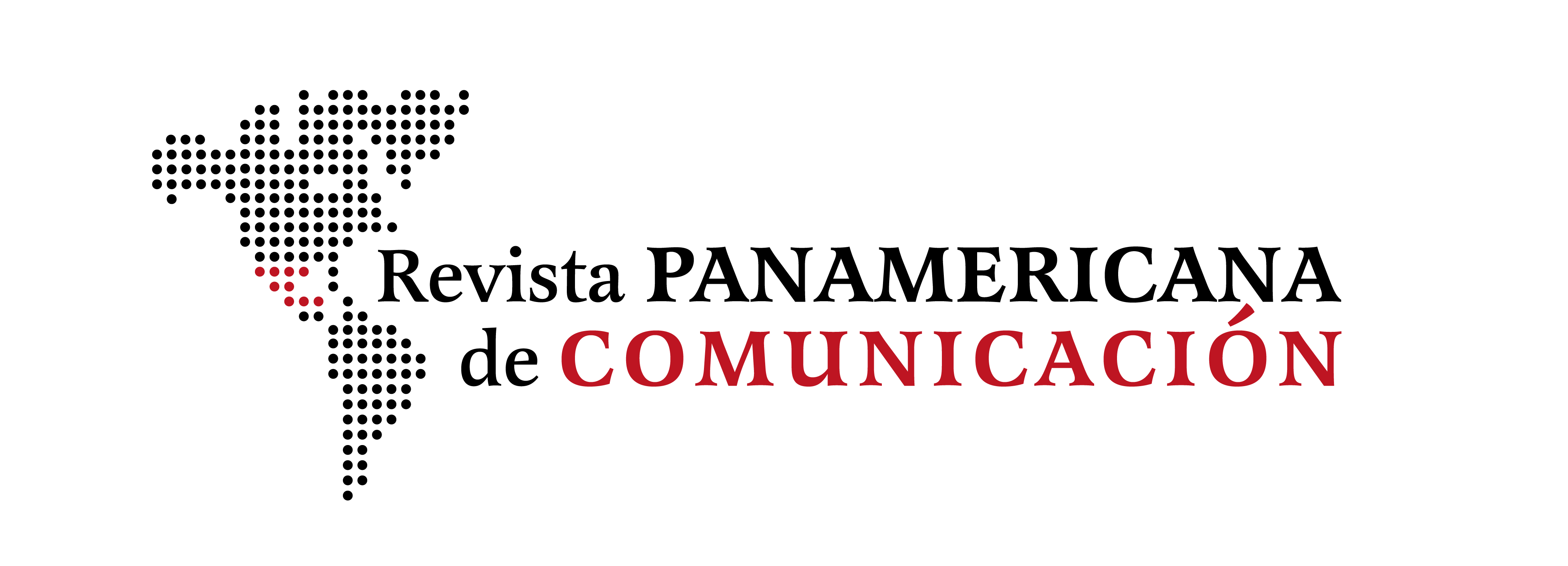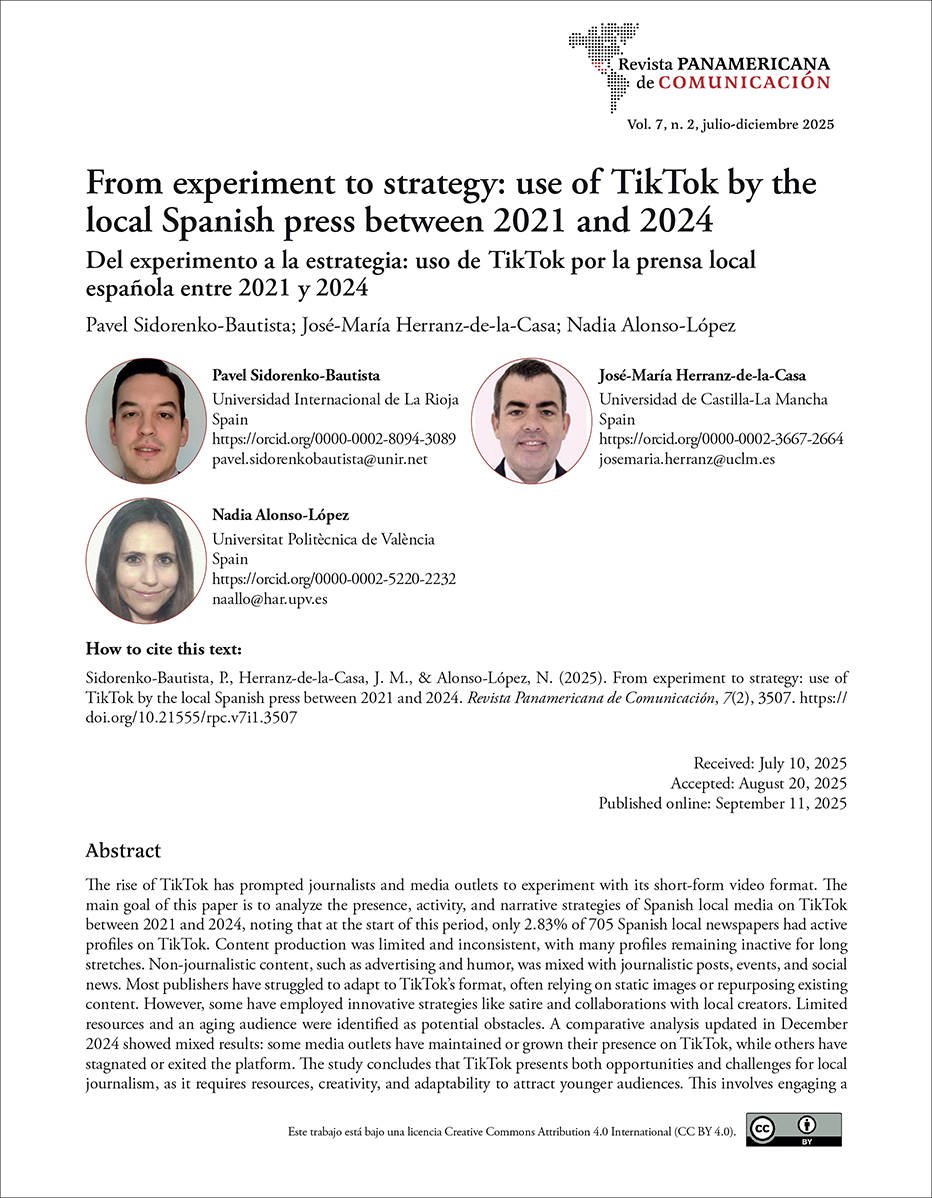From experiment to strategy: use of TikTok by the local Spanish press between 2021 and 2024
Contenido principal del artículo
Resumen
The rise of TikTok has prompted journalists and media outlets to experiment with its short-form video format. The main goal of this paper is to analyze the presence, activity, and narrative strategies of Spanish local media on TikTok between 2021 and 2024, noting that at the start of this period, only 2.83% of 705 Spanish local newspapers had active profiles on TikTok. Content production was limited and inconsistent, with many profiles remaining inactive for long stretches. Non-journalistic content, such as advertising and humor, was mixed with journalistic posts, events, and social news. Most publishers have struggled to adapt to TikTok’s format, often relying on static images or repurposing existing content. However, some have employed innovative strategies like satire and collaborations with local creators. Limited resources and an aging audience were identified as potential obstacles. A comparative analysis updated in December 2024 showed mixed results: some media outlets have maintained or grown their presence on TikTok, while others have stagnated or exited the platform. The study concludes that TikTok presents both opportunities and challenges for local journalism, as it requires resources, creativity, and adaptability to attract younger audiences. This involves engaging a global audience with content of local interest and informing emerging viewers who now depend on this platform as their main source of information.
Detalles del artículo
Sección

Esta obra está bajo una licencia internacional Creative Commons Atribución 4.0.
Cómo citar
Referencias
Abidin, C. (2020). Mapping internet celebrity on TikTok: Exploring attention economies and visibility labours. Cultural Science Journal, 12(1), 77-103. https://doi.org/gdvc
Alonso-González, M. (2019). Fake news: desinformación en la era de la sociedad de la información. Ámbitos. Revista internacional de Comunicación, 45 29-52. https://doi.org/10.12795/Ambitos.2019.i45.03
Alonso-López, N., Sidorenko-Bautista, P. & Giacomelli, F. (2021). Beyond challenges and viral dance moves: TikTok as a vehicle for disinformation and fact-checking in Spain, Portugal, Brazil, and the USA. Anàlisi: Quaderns de Comunicació I Cultura, 64, 65-84. https://doi.org/10.5565/rev/analisi.3411
Anguí-Sánchez, D., Cabezuelo-Lorenzo, F., & Sotelo-González, J. (2019). Innovación tecnológica y social en los nuevos medios digitales norteamericanos. Análisis del caso de Quartz News. Revista Latina de Comunicación Social, 74, 1697-1713. https://doi.org/10.4185/RLCS-2019-1405
Bayer, J. B., Ellison, N. B., Schoenebeck, S. Y., & Falk, E. B. (2016). Sharing the small moments: Ephemeral social interaction on Snapchat. Information, Communication & Society, 19(7), 956–977.
Blasco-Doñamayor., E. (2021). Historias en Instagram e Instagram Stories: relatos en 15 segundos. In A. Urrutia y A. Calvo (eds.). Escrituras enREDadas (pp. 209-224). Iberoamericana Editorial Vervuert.
Boczkowski, P. J. (2004). Digitizing the news: Innovation in online newspapers. MIT Press. https://doi.org/10.7551/mitpress/2435.001.0001
Camponez, C. (2017). Proposta de novos pactos comunicacionais na era do hiperlocal. In P. Jerónimo (Ed.), Media e jornalismo de proximidade na era digital (11-26). Editora LabCom IFP.
Canavilhas, J. (2007). Webnoticia: propuesta de modelo periodístico para la WWW. Editora LabCom IFP.
Cardoso, G. & Schweidler, C. (2014). Movilización social y medios sociales. Vanguardia Dossier: el poder de las redes, 50, 6-13.
Casero-Ripollés, A. (2020). Impact of Covid-19 on the media system. Communicative and democratic consequences of news consumption during the outbreak. Profesional de la Información, 29(2), e290223. https://doi.org/10.3145/epi.2020.mar.23
Castellet, A., Aguado, J. M, & Martínez-Martínez, I. J. (2013). Los nuevos actores que cambian las reglas y el juego. Cómo Apple y Google han transformado la distribución de contenidos. In K. Zilles, J. Cuenca, & j. Rom (Eds.), Breaking the media vale chain. VII International Conference on Communication and Relity (pp. 333-342). https://bit.ly/3BECkbz
Chalipah, D., Dzatil-Ishmah, H., Masitoh, I., Azzahrah, L., Nava-Edrea, S. & Chardi-Subing, N. (2025). The esssence of TikTok social media content. Opportunities and challenges in popularizing local cultural identity. Historia, Journal of History Education, 1(1), 28-37. https://journal.cerdasnusantara.org/index.php/historia/article/view/27
Chan, J. (2021, May 4). Top apps worldwide for april 2021 by downloads. Sensor Tower. https://bit.ly/3euF6Xb
Cohen, J. (1960). A coefficient of agreement for nominal scales. Educational and Psychological Measurement, 20(1), 37-46. https://doi.org/10.1177/001316446002000104
Coleman, S., Morrison, D. E., & Anthony, S. (2012). A constructivist study of trust in the news. Journalism Studies, 13(1), 37-53. https://doi.org/10.1080/1461670X.2011.592353
Deggen, M., Olgemöller, M., & Zabel, C. (2024). The tortured journalists department? Challenges and Characteristics of Quality Journalism on TikTok in Germany. Emerging Media, 2(4), 673-697. https://doi.org/10.1177/27523543241300942
Ditrendia (2020). Mobile en España y en el Mundo 2020. https://bit.ly/3iY6iwV
Feng, Y. L., Chen, C. C., Wu, S. M. (2019). Evaluation of charm factors of short video user experience using FAHP – a case study of TikTok app. IOP Conference Series: Materials Science and Engineering, 688, 1-5. https://doi.org/10.1088/1757-899X/688/5/055068
Fundación Telefónica (2020). Sociedad Digital en España 2019. Taurus.
Giddens, A. (2003). Runaway world: How globalisation is reshaping our lives. Routledge
Gómez, A. (2019. Manual urgente de periodismo en tiempos de redes sociales (en 333 tuits). Amazon Fulfillment.
Haitao, M., Abbas-Ali, D., & Ping, W. (2024). TikTok research on the intermediary role of short video news in braking through local realtions. Media and Communication Reasearch, 5(2), 66-71. https://doi.org/10.23977/mediacr.2024.050210
Heitmayer, M. (2024). The second wave of attention economics. attention as a universal symbolic currency on social media and beyond. Intetacting with computers, 37(1), 18-29. https://doi.org/10.1093/iwc/iwae035
Herranz-de-la-Casa, J. M., Sidorenko-Bautista, P., & Cantero-de-Julián, J. I. (2019). Realidad virtual y periodismo inmersivo: nuevas formas de contar historias para los periodistas. In M. J. Ufarte (Coord.), Nuevos perfiles profesionales para el mercado periodístico (pp. 127-148). Comunicación Social.
Hill, S., & Bradshaw, P. (2019). Mobile-first journalism. Routledge
Hjelm, J. (2000). Designing wireless information services. John Wiley & Sons
Huttayavilaiphan, R. (2024). From local flavor to global fandom: an exploration of the cultural presentation and attitudes towards using English by Thai content creators on the TikTok platform. Frontiers in Communication, 9, 1453316. https://doi.org/10.3389/fcomm.2024.1453316
IAB (2024). Estudio de redes sociales 2024. https://iabspain.es/estudio/estudio-de-redes-sociales-2024
IAB (2025). Estudio de redes sociales 2025. https://iabspain.es/estudio/estudio-redes-sociales-2025-iab-spain
Jerónimo, P. (2015). Ciberjornalismo de proximidade. Editora LabCom IFP
Kantar (2020, June 15). TikTok is the Brand to watch: BrandZ Global Top 100 2020. https://www.kantar.com/inspiration/brands/tiktok-is-the-brand-to-watch-brandz-global-top-100-2020
Krippendorff, K. (2011). Computing Krippendorff’s alpha-reliability. Working Paper, Departmental Papers (ASC). https://repository.upenn.edu/handle/20.500.14332/2089
Landis J. R., & Koch G. G. (1977) The measurement of observer agreement for categorical data. Biometrics. 33(1), 159-74. PMID: 843571. https://pubmed.ncbi.nlm.nih.gov/843571
Li, X., Xiaohui, Y., & Zhengwu, Z. (2019). Research on the causes of the “TikTok” app becoming popular and the existing problems. Journal of advanced management science, 7(2), 59-63
Lu, M. (2021, June 22). How media consuption evolved troughout COVID-19. Visual capitalist. https://www.visualcapitalist.com/how-media-consumption-evolved-throughout-covid-19
López-Morales, J. S. (2021). Glocality. In S. Idowu et al. (eds.). Encyclopedia of Sustainable Management. Springer. https://doi.org/10.1007/978-3-030-02006-4_331-1
Ma, L., Feng, J., Feng, Z., & Wang, L. (2019). Research on user loyalty of short video app based on perceived value – take TikTok as an example. 16th International Conference on Service Systems and Service Management (ICSSSM), Shenzhen, China, 20191-6. https://doi.org/10.1109/ICSSSM.2019.8887751
Manfredi-Sánchez, J., & Artero, J. P. (2014). New business models for the media: the Spanish case. In E. Psychogiopoulou (Ed.), Media policies revisited. The challenge formedia freedom and independence (pp. 160-174). Palgrave Macmillan.
Manfredi-Sánchez, J., Ufarte-Ruiz, M., & Herranz-de-la-Casa, J. (2019). Innovación periodística y sociedad digital: Una adaptación de los estudios de Periodismo. Revista Latina de Comunicación Social, (74), 1633-1654. https://doi.org/10.4185/RLCS-2019-1402
Nee, R. C. (2013). Creative destruction: An exploratory study of how digitally native news nonprofits are innovating online journalism practices. International journal on media management, 15(1), 3-22. https://doi.org/10.1080/14241277.2012.732153
Newman, N., & Cherubini, F. (2025). Journalism and technology. trends and predictions. Reuters Institue – University of Oxford. https://doi.org/10.60625/risj-vte1-x706
Parry, E., & Urwin, P. (2011). Generational differences in work values: a review of theory and evidence. International Journal of Management Reviews, 13(1). 79-96. https://doi.org/10.1111%2Fj.1468-2370.2010.00285.x
Palacio, L. (2020). Prensa local: un modelo en cuestión. Cuadernos de Periodistas, 40. https://www.cuadernosdeperiodistas.com/prensa-local-un-modelo-en-cuestion
Ramos, G., & Grupillo, A. (2020). Jornalismo regional em novas plataformas. In P. Jerónimo, & J. C. Correia (Eds.) O pulsar da proximidade nos media e no jornalismo (pp. 31-46). Editora LabCom IFP.
Rulyova, N., & Westley, H. (2017). Changing news genres as a result of global technological developments. Digital Journalism, 5(8), 1-20. https://doi.org/10.1080/21670811.2017.1351882
Salaverría, R. (2018, January 16). Allá donde estés habrá noticias [online]. Cuadernos de periodistas, 35, 15-22. https://cuadernosdeperiodistas.com/alla-donde-estes-habra-noticias
Serrano, P. (2017). La transformación digital de una redacción y el periodismo móvil (MOJO). Ediciones UOC.
Sidorenko-Bautista, P., & Garrido-Pintado, P. (2021). El microformato informativo en los relojes inteligentes. El caso de la aplicación “RTVE Informativos 24 horas”. Improntas de la Historia y la Comunicación, 9, e043, 1-18. https://doi.org/10.24215/24690457e043
Sidorenko-Bautista, P., & Herranz-de-la-Casa, J. M. (2020, December 14). ¿Es posible el periodismo en TikTok?. Revista Telos. Fundación Telefónica. https://telos.fundaciontelefonica.com/es-posible-el-periodismo-en-tiktok
Sidorenko-Bautista, P., Herranz-de-la-Casa, J. M., & Cantero-de-Julián, J. I. (2020). Use of new narratives for COVID-19 reporting: from 360º videos to ephemeral TikTok videos in online media. Trípodos, 47(1), 105-122. https://raco.cat/index.php/Tripodos/article/view/377177
Sidorenko-Bautista, P., Herranz-de-la-Casa, J. M., & Moya-Ruíz, A. S. (2021). Análisis de la comunicación de empresas europeas y norteamericanas en TikTok. aDResearch, 25(25), 106-123. https://doi.org/gbk2
Vásquez-Herrero, J., Negreira-Rey, M. C., & López-García, X. (2020). Let´s dance the news! How the news media has adapting to the logic of TikTok. Journalism, 1-19. https://doi.org/10.1177/1464884920969092
Villena-Alarcón, E., Fernández-Torres, M. J., & Cristófol-Rodríguez, C. (2020). La comunicación de las empresas de moda en TikTok: ASOS como caso de estudio. Red Marka. Revista de Marketing Aplicado, 24(2), 95-109. https://doi.org/10.17979/redma.2020.24.2.7071
Wongpakaran, N., Wongpakaran, T., Wedding, D., Gwet, K. L. (2013). A comparison of Cohen’s Kappa and Gwet’s AC1 when calculating inter-rater reliability coefficients: a study conducted with personality disorder samples. BMC Medical Research Methodology, 13(61). https://doi.org/10.1186/1471-2288-13-61
Xiang, B. (2018, June 17). Chinese video sharing app boasts 500 mln monthly active users. Xinhua Net. https://bit.ly/3hKim7M
Yang, S., Zhao, Y., & Ma, Y. (2019). Analysis of the reasons and development of short video application – Taking Tik Tok as an example. 9th International Conference on Information and Social Science (ICISS 2019), 340-343, Francis Academic Press. https://webofproceedings.org/proceedings_series/article/artId/10287.html

